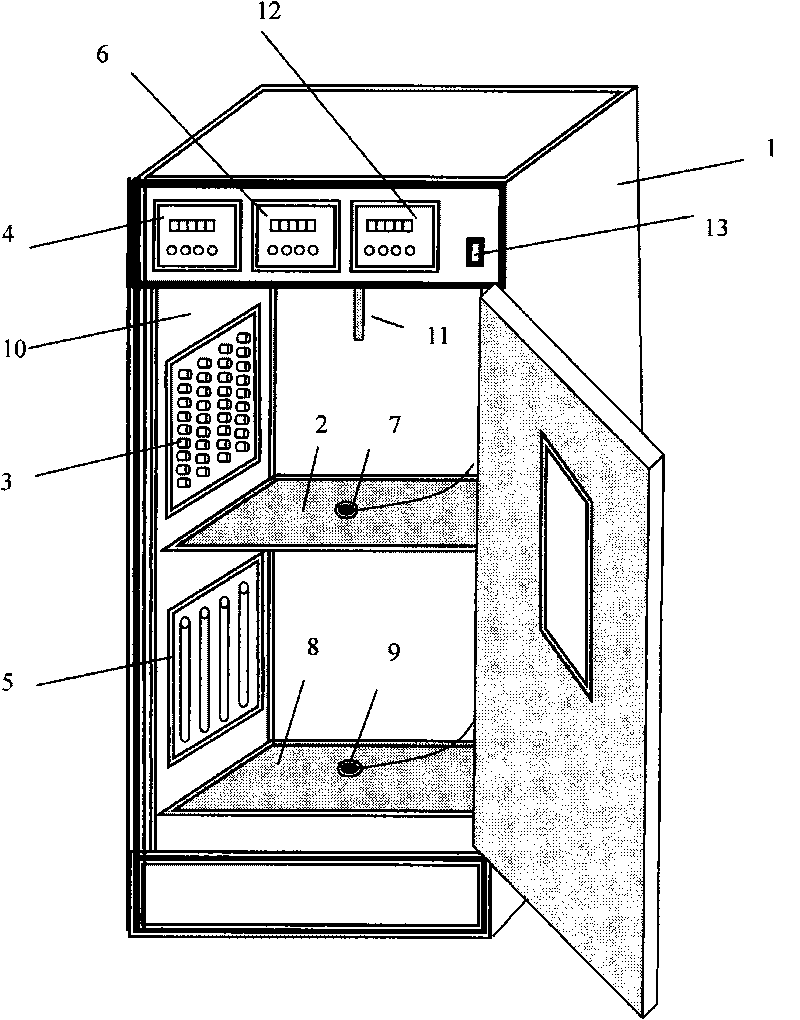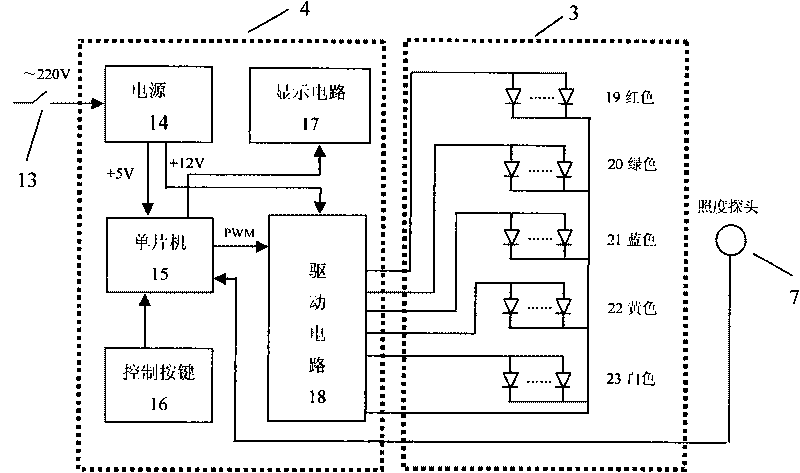Method and device for performing microalgae culture experiment by using LED dimmable light
A technology for microalgae cultivation and experimental equipment, which is applied in the field of equipment for microalgae cultivation experiments, can solve the problems of inability to adjust the optimal environment for microalgae growth, high power consumption, and low efficiency, and achieve light efficiency and stable longevity. The effect of less heat generation and high light efficiency
- Summary
- Abstract
- Description
- Claims
- Application Information
AI Technical Summary
Problems solved by technology
Method used
Image
Examples
Embodiment 1
[0023] A device for microalgae cultivation experiments with LED dimmable light.
[0024] exist figure 1 Among them, the device is composed of a box body 1, a ventilation and light-shielding board 2, an LED control circuit 4, a fluorescent lamp control circuit 6, a temperature control circuit 12 in the box, an LED lighting assembly 3 and a fluorescent lamp lighting assembly 5. In the box body 1 , the whole box body is divided into upper and lower parts by a ventilating and light-shielding plate 2 . The ventilation and light insulation board 2 is composed of a louver metal sheet structure. The upper half of the box 1 is used for LED lighting cultivation, and the lower half of the box 1 is used for fluorescent tube control cultivation. A light-emitting component 3 consisting of 100 high-brightness LEDs with a diameter of 5mm in each of red, green, blue, yellow and white is installed on both sides of the upper half. The peak wavelengths are: red 650nm, green 520nm, blue 440nm, y...
Embodiment 2
[0027] A method for carrying out microalgae cultivation experiments with the device described in Example 1.
[0028] (1) Algae species: Chaetoceros gracilis microalgae were selected as the experimental object, and the algae species were obtained from the algae species bank of the School of Fisheries, Ocean University of China.
[0029] (2) Selection of lighting scheme: take blue LED (B) + green LED (G) spectral combination, and the control light source is fluorescent lamp. The light cycle of the two light sources is 18 hours on and 6 hours off. The light intensity is controlled at 4000Lx.
[0030] (3) Cultivation method: After seawater is filtered, it is boiled and sterilized, and after cooling, a nutrient solution is prepared, and the culture solution uses F / 2 nutrient salt formula. The salinity is 25‰, pH7.5, temperature 25.5±0.5°C, shake the flask three times a day, set three replicate samples for each experimental group, and take the average of the measurement results.
...
Embodiment 3
[0036] A method for carrying out microalgae cultivation experiments with the device described in Example 1.
[0037] The algae species were Platymonas subcordiformis microalgae, which were obtained from the Algae Species Bank of the Fisheries College of Ocean University of China. Illumination scheme selection: blue LED (B) + red LED (R) spectrum combination, and the contrast light source is fluorescent lamp. The photoperiod of the two light sources is 18 hours on and 6 hours off, and the light intensity is controlled at 4000Lx. The cultivation method and measurement method are the same as in Example 2.
[0038] Measurement results: see the attached cell density curves for blue-red (BR) LED light source and fluorescent light growth cell density curve Figure 4 . The growth rate under the BR light source was 0.418; while the growth rate under the fluorescent light source was 0.363. This shows that for the subcardioid algae under the same light intensity and light cycle, the ...
PUM
 Login to View More
Login to View More Abstract
Description
Claims
Application Information
 Login to View More
Login to View More - R&D
- Intellectual Property
- Life Sciences
- Materials
- Tech Scout
- Unparalleled Data Quality
- Higher Quality Content
- 60% Fewer Hallucinations
Browse by: Latest US Patents, China's latest patents, Technical Efficacy Thesaurus, Application Domain, Technology Topic, Popular Technical Reports.
© 2025 PatSnap. All rights reserved.Legal|Privacy policy|Modern Slavery Act Transparency Statement|Sitemap|About US| Contact US: help@patsnap.com



